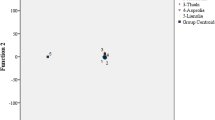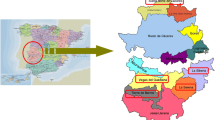Abstract
Virgin olive oil samples of eight varieties from four regions (North Aegean, South Aegean, Mediterranean, and Southeastern) of Turkey were discriminated using fatty acid and sterol composition. Principle component analysis represented a separation of South Aegean olive oils from the rest of the sample groups, that mainly depend on Stigmasterol, β-sitosterol, Δ5,24-Stigmastadienol, Δ7-Avenasterol, C17:0, and C17:1 variables. Except few overlaps, North Aegean samples were also discriminated with Mediterranean and Southeastern samples. The varietal separation was not interpretable by itself but since all samples from South Aegean region were Memecik variety, regional separation has become clearer. Soft independent modeling of class analogy shows good separation between North and South Aegean samples with only a few exceptions. The number of misestimated samples was high at Mediterranean and Southeastern models on Coomans’ plots because of high variance within each group. Partial least squares discrimination analysis was more successful than Soft independent modeling of class analogy. The prediction capabilities of South Aegean and North Aegean models were better than others. Root mean squared error of prediction and goodness of prediction were 0.092 and 0.961 for South Aegean, 0.182, and 0.853 for North Aegean, respectively. Unlikely to soft independent modeling of class analogy, Southeastern and Mediterranean samples were not rejected but remained as “uncertain” on partial least squares discrimination analysis with the help of its algorithm.





Similar content being viewed by others
References
Maléchaux A, Le Dréau Y, Vanloot P et al (2019) Discrimination of extra virgin olive oils from five French cultivars: en route to a control chart approach. Food Control 106:106691. https://doi.org/10.1016/j.foodcont.2019.06.017
Tsimidou MZ, Ordoudi SA, Nenadis N, Mourtzinos I (2015) Food Fraud, 1st edn. Elsevier Ltd., USA
Cecchi L, Migliorini M, Giambanelli E et al (2020) Authentication of the geographical origin of virgin olive oils from the main worldwide producing countries: a new combination of HS-SPME-GC-MS analysis of volatile compounds and chemometrics applied to 1217 samples. Food Control 112:107156. https://doi.org/10.1016/j.foodcont.2020.107156
European Commission (2020) eAmbrosia—the EU geographical indications register. https://ec.europa.eu/info/food-farming-fisheries/food-safety-and-quality/certification/quality-labels/geographical-indications-register/. Accessed 8 Apr 2020
Esteki M, Simal-Gandara J, Shahsavari Z et al (2018) A review on the application of chromatographic methods, coupled to chemometrics, for food authentication. Food Control 93:165–182. https://doi.org/10.1016/j.foodcont.2018.06.015
Gerbig S, Neese S, Penner A et al (2017) Real-time food authentication using a miniature mass spectrometer. Anal Chem 89:10717–10725. https://doi.org/10.1021/acs.analchem.7b01689
Mele MA, Islam MZ, Kang HM, Giuffrè AM (2018) Pre-and post-harvest factors and their impact on oil composition and quality of olive fruit. Emirates J Food Agric 30:592–603. https://doi.org/10.9755/ejfa.2018.v30.i7.1742
Kalua CM, Allen MS, Bedgood DR et al (2007) Olive oil volatile compounds, flavour development and quality: a critical review. Food Chem 100:273–286. https://doi.org/10.1016/j.foodchem.2005.09.059
Abdallah M, Vergara-Barberán M, Lerma-García MJ et al (2016) Classification of Tunisian extra virgin olive oils according to their genetic variety and maturity index using fatty acid profiles established by direct infusion mass spectrometry. Eur J Lipid Sci Technol 118:735–743. https://doi.org/10.1002/ejlt.201500230
Bozdogan Konuskan D, Mungan B (2016) Effects of variety, maturation and growing region on chemical properties, fatty acid and sterol compositions of virgin olive oils. J Am Oil Chem Soc 93:1499–1508. https://doi.org/10.1007/s11746-016-2904-8
Li X, Flynn JD, Wang SC (2019) The effects of variety, growing region, and drought stress on fatty acid and sterol compositions of California olive oil. JAOCS J Am Oil Chem Soc 96:215–230. https://doi.org/10.1002/aocs.12192
Gómez-Caravaca AM, Maggio RM, Cerretani L (2016) Chemometric applications to assess quality and critical parameters of virgin and extra-virgin olive oil. A review. Anal Chim Acta 913:1–21. https://doi.org/10.1016/j.aca.2016.01.025
Ün İ, Ok S (2018) Analysis of olive oil for authentication and shelf life determination. J Food Sci Technol 55:2476–2487. https://doi.org/10.1007/s13197-018-3165-3
Ghisoni S, Lucini L, Angilletta F et al (2019) Discrimination of extra-virgin-olive oils from different cultivars and geographical origins by untargeted metabolomics. Food Res Int 121:746–753. https://doi.org/10.1016/j.foodres.2018.12.052
El Riachy M, Hamade A, Ayoub R et al (2019) Oil content, fatty acid and phenolic profiles of some olive varieties growing in Lebanon. Front Nutr 6:94. https://doi.org/10.3389/fnut.2019.00094
Jiménez-Carvelo AM, Cruz CM, Olivieri AC et al (2019) Classification of olive oils according to their cultivars based on second-order data using LC-DAD. Talanta 195:69–76. https://doi.org/10.1016/j.talanta.2018.11.033
Crizel RL, Hoffmann JF, Zandoná GP et al (2020) Characterization of extra virgin olive oil from Southern Brazil. Eur J Lipid Sci Technol 1900347:11–14. https://doi.org/10.1002/ejlt.201900347
Martakos I, Kostakis M, Dasenaki M et al (2020) Simultaneous determination of pigments, tocopherols, and squalene in Greek olive oils: a study of the influence of cultivation and oil-production parameters. Foods 9:31. https://doi.org/10.3390/foods9010031
Gurdeniz G, Ozen B, Tokatli F (2008) Classification of Turkish olive oils with respect to cultivar, geographic origin and harvest year, using fatty acid profile and mid-IR spectroscopy. Eur Food Res Technol 227:1275–1281. https://doi.org/10.1007/s00217-008-0845-7
Deiana P, Santona M, Dettori S et al (2019) Multivariate approach to assess the chemical composition of Italian virgin olive oils as a function of variety and harvest period. Food Chem 300:125243. https://doi.org/10.1016/j.foodchem.2019.125243
Medina S, Perestrelo R, Silva P et al (2019) Current trends and recent advances on food authenticity technologies and chemometric approaches. Trends Food Sci Technol 85:163–176. https://doi.org/10.1016/j.tifs.2019.01.017
Lee LC, Liong CY, Jemain AA (2018) Partial least squares-discriminant analysis (PLS-DA) for classification of high-dimensional (HD) data: a review of contemporary practice strategies and knowledge gaps. Analyst 143:3526–3539. https://doi.org/10.1039/c8an00599k
Gumus ZP, Celenk VU, Tekin S et al (2017) Determination of trace elements and stable carbon isotope ratios in virgin olive oils from Western Turkey to authenticate geographical origin with a chemometric approach. Eur Food Res Technol 243:1719–1727. https://doi.org/10.1007/s00217-017-2876-4
Gökçebağ M, Dıraman H, Özdemir D (2013) Classification of Turkish monocultivar (AyvalIk and Memecik cv.) virgin olive oils from north and south zones of Aegean region based on their triacyglycerol profiles. JAOCS J Am Oil Chem Soc 90:1661–1671. https://doi.org/10.1007/s11746-013-2308-y
Dıraman H, Saygı H, Hışıl Y (2011) Geographical classification of Turkish virgin olive oils from the Aegean Region for two harvest years based on their fatty acid profiles. JAOCS J Am Oil Chem Soc 88:1905–1915. https://doi.org/10.1007/s11746-011-1862-4
Kritioti A, Menexes G, Drouza C (2018) Chemometric characterization of virgin olive oils of the two major Cypriot cultivars based on their fatty acid composition. Food Res Int 103:426–437. https://doi.org/10.1016/j.foodres.2017.10.064
Karabagias I, Michos C, Badeka A et al (2013) Classification of Western Greek virgin olive oils according to geographical origin based on chromatographic, spectroscopic, conventional and chemometric analyses. Food Res Int 54:1950–1958. https://doi.org/10.1016/j.foodres.2013.09.023
Ben TS, Manai H, Methenni K et al (2008) Sterolic composition of Chétoui virgin olive oil: influence of geographical origin. Food Chem 110:368–374. https://doi.org/10.1016/j.foodchem.2008.02.012
Guissous M, Le Dréau Y, Boulkhroune H et al (2018) Chemometric characterization of eight monovarietal Algerian Virgin Olive Oils. JAOCS J Am Oil Chem Soc 95:267–281. https://doi.org/10.1002/aocs.12030
Tapp HS, Defernez M, Kemsley EK (2003) FTIR spectroscopy and multivariate analysis can distinguish the geographic origin of extra virgin olive oils. J Agric Food Chem 51:6110–6115. https://doi.org/10.1021/jf030232s
Hair et.al (2019) Multivariate data analysis. 8th edn. Annabel Ainscow
Alkan D, Tokatli F, Ozen B (2012) Phenolic characterization and geographical classification of commercial extra virgin olive oils produced in Turkey. JAOCS J Am Oil Chem Soc 89:261–268. https://doi.org/10.1007/s11746-011-1917-6
Borràs E, Ferré J, Boqué R et al (2016) Olive oil sensory defects classification with data fusion of instrumental techniques and multivariate analysis (PLS-DA). Food Chem 203:314–322. https://doi.org/10.1016/j.foodchem.2016.02.038
Acknowledgements
Thanks to the Tariş Olive and Olive Oil Agriculture Sales Cooperatives Union refinery in Çiğli, İzmir, for providing samples and the kind contribution in chemical analyses.
Funding
Not applicable.
Author information
Authors and Affiliations
Corresponding author
Ethics declarations
Conflict of interest
There is no conflict of interest.
Availability of data and material
Raw data not presented.
Additional information
Publisher's Note
Springer Nature remains neutral with regard to jurisdictional claims in published maps and institutional affiliations.
Rights and permissions
About this article
Cite this article
Özdikicierler, O. Chemometric discrimination of Turkish olive oils by variety and region using PCA and comparison of classification viability of SIMCA and PLS-DA. Eur Food Res Technol 247, 157–168 (2021). https://doi.org/10.1007/s00217-020-03614-9
Received:
Revised:
Accepted:
Published:
Issue Date:
DOI: https://doi.org/10.1007/s00217-020-03614-9




